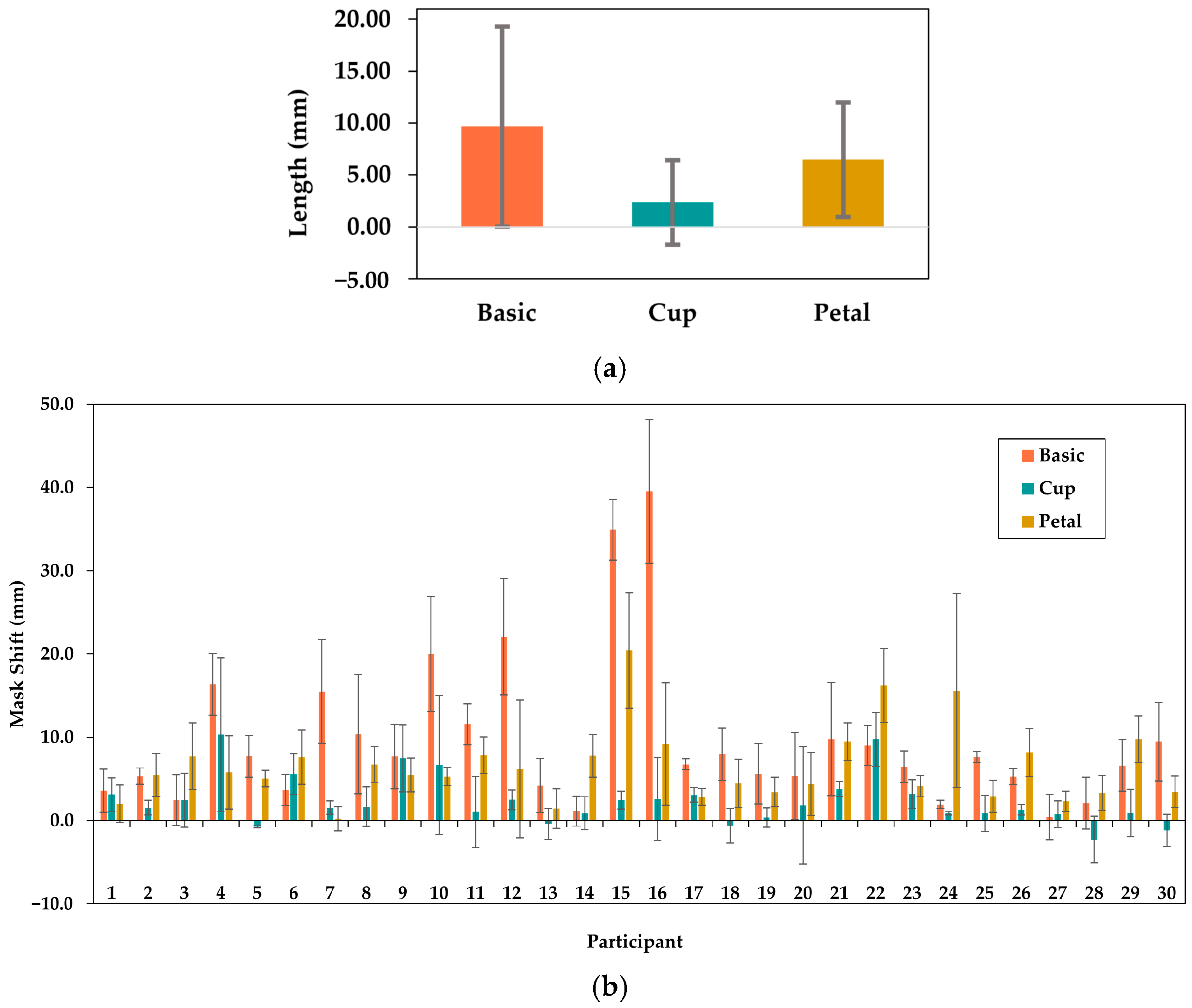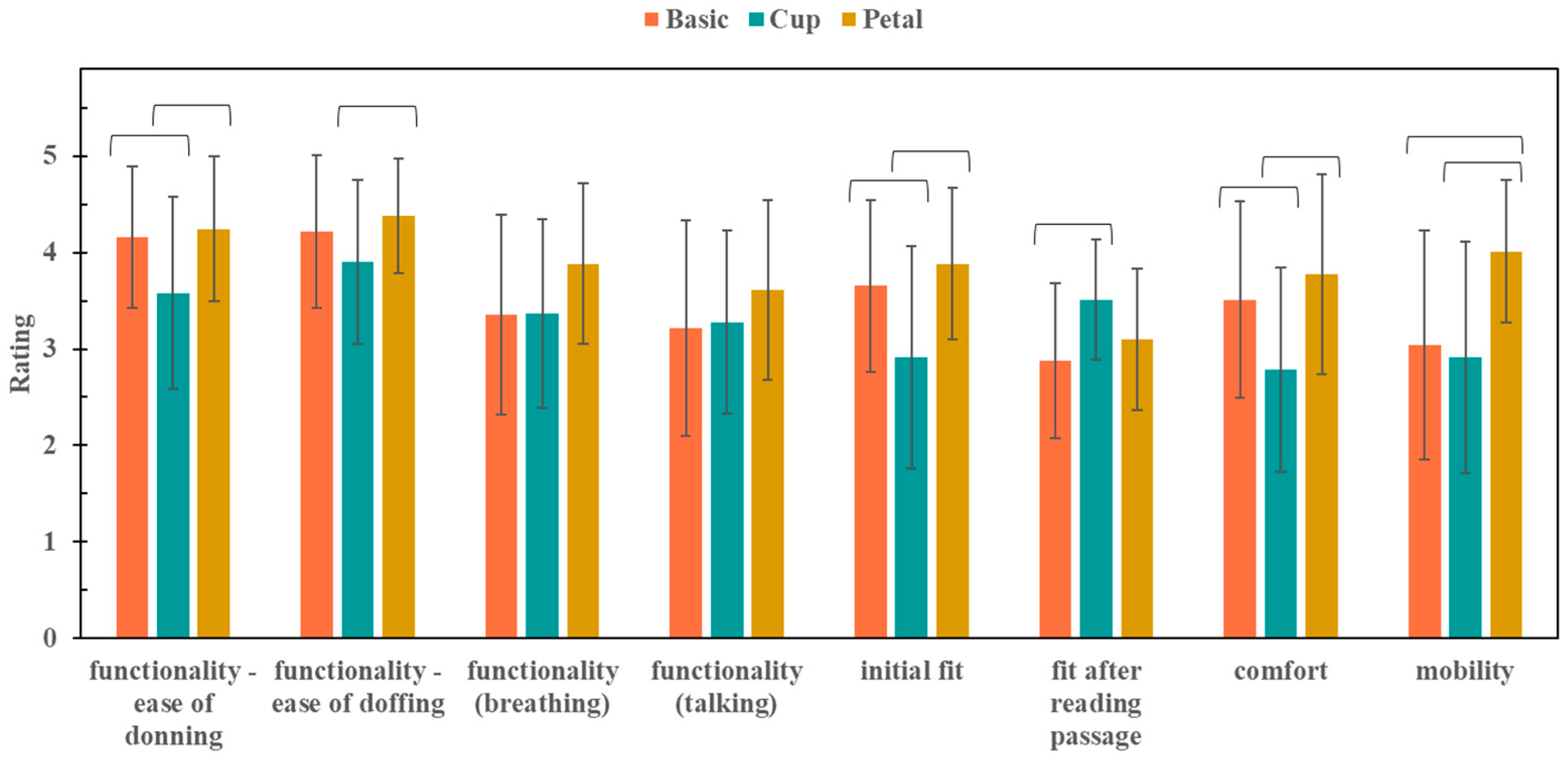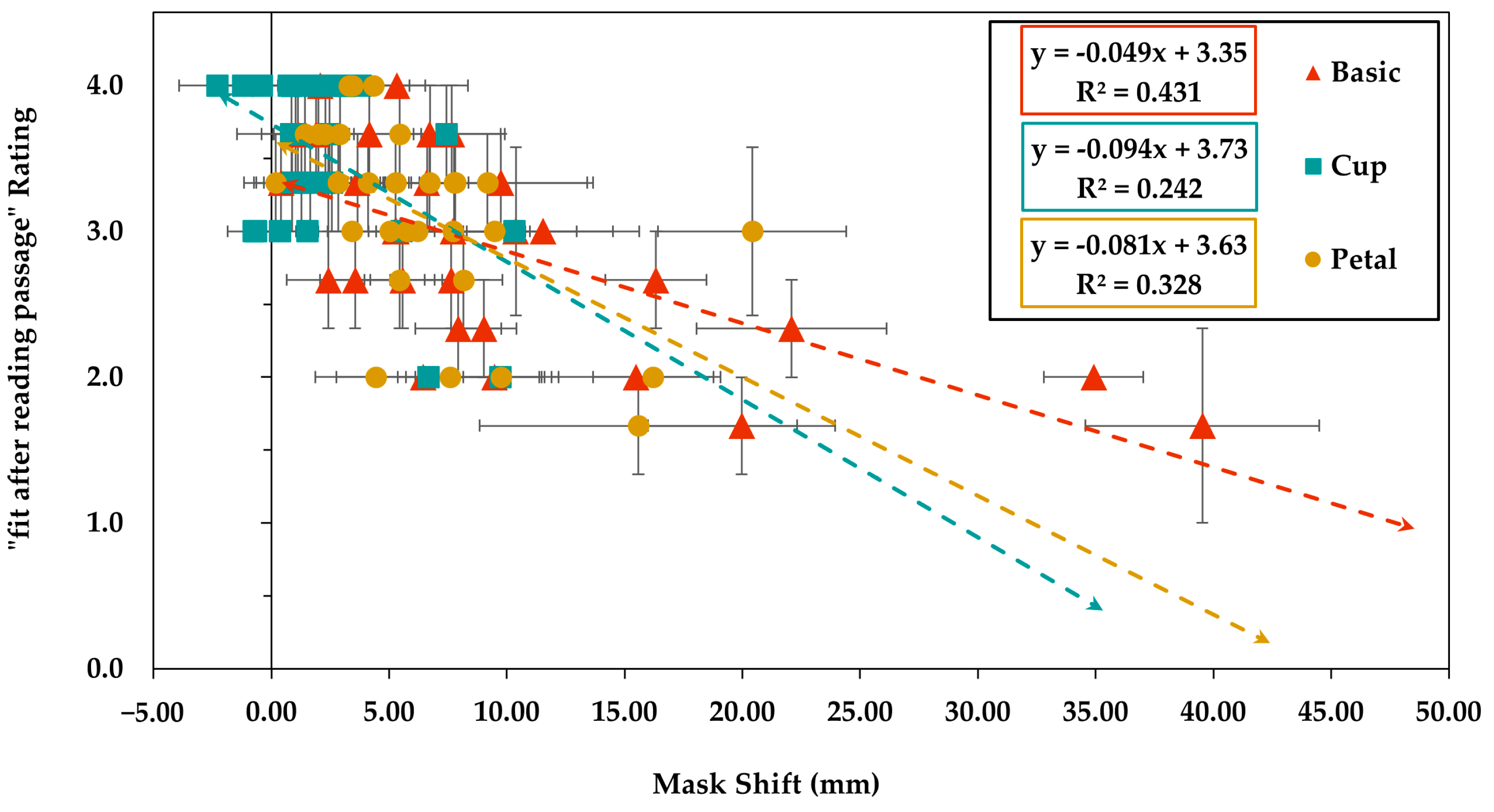Development of a Method to Evaluate the Dynamic Fit of Face Masks
Abstract
:1. Introduction
2. Materials and Methods
2.1. Face Mask Designs
2.2. Three-Dimensional Head Scanning
2.3. Extraction of Face and Mask Measurements
2.3.1. Face Functional Measurements
2.3.2. Mask Shift Measurement
2.4. Data Analysis
3. Results
3.1. Demographics
3.2. Participant Anthropometrics
3.2.1. Frankfurt Plane
3.2.2. Closed-Mouth Versus Open-Mouth Dimensions
3.3. Quantitative Fit Analysis
3.3.1. Mask Shift
3.3.2. Correlation Between Face Measurements and Mask Shift
3.4. Qualitative Fit Analysis
3.4.1. Mask Overlays
3.4.2. Participant Questionnaire
3.4.3. Agreement Between Overall and Individual Ratings
4. Conclusions
Supplementary Materials
Author Contributions
Funding
Data Availability Statement
Acknowledgments
Conflicts of Interest
References
- Ferri, A.; Barla, M.; Campagnaro, C.; Dotti, F.; Dugoni, M.; Marchesa, G.; Mozzone, D.; Vallan, A. Design and Validation of a Cloth Face Covering (CFC) with Low Breathing Resistance for Sports Practice. In Proceedings of the 2022 IEEE International Workshop on Sport, Technology and Research (STAR), Trento, Italy, 6–8 July 2022; pp. 106–110. [Google Scholar] [CrossRef]
- Bergmann, K.-C.; Kugler, S.; Zuberbier, T.; Becker, S. Face Masks Suitable for Preventing COVID-19 and Pollen Allergy. A Study in the Exposure Chamber. Allergo J. Int. 2021, 30, 176–182. [Google Scholar] [CrossRef] [PubMed]
- Liang, M.; Gao, L.; Cheng, C.; Zhou, Q.; Uy, J.P.; Heiner, K.; Sun, C. Efficacy of Face Mask in Preventing Respiratory Virus Transmission: A Systematic Review and Meta-Analysis. Travel Med. Infect. Dis. 2020, 36, 101751. [Google Scholar] [CrossRef] [PubMed]
- Morishima, M.; Kishida, K.; Uozumi, T.; Kamijo, M. Experiences and Problems with Hygiene Masks Reported by Japanese Hay Fever Sufferers. Int. J. Cloth. Sci. Technol. 2014, 26, 262–273. [Google Scholar] [CrossRef]
- Mumma, J.M.; Jordan, E.; Ayeni, O.; Kaufman, N.; Wheatley, M.J.; Grindle, A.; Morgan, J. Development and Validation of the Discomfort of Cloth Masks-12 (DCM-12) Scale. Appl. Ergon. 2022, 98, 103616. [Google Scholar] [CrossRef]
- Mumma, J.; Liu, F.; Ng, N.L.; Morgan, J.; Lane, M.; Gannon, P. Designing Better Cloth Masks: The Effect of Fabric and Attachment-Style on Discomfort. J. Occup. Environ. Hyg. 2023, 20, 23–32. [Google Scholar] [CrossRef]
- Amirav, I.; Luder, A.S.; Halamish, A.; Marzuk, C.; Daitzchman, M.; Newhouse, M.T. Computerized Dead-Space Volume Measurement of Face Masks Applied to Simulated Faces. Respir. Care 2015, 60, 1247–1251. [Google Scholar] [CrossRef]
- Chen, Y.; Wang, J.; Yang, Z. The Human Factors/Ergonomics Studies for Respirators: A Review and Future Work. Int. J. Cloth. Sci. Technol. 2015, 27, 652–676. [Google Scholar] [CrossRef]
- Hsiao, H. Anthropometric Procedures for Protective Equipment Sizing and Design. Hum. Factors 2013, 55, 6–35. [Google Scholar] [CrossRef]
- Chopra, J.; Abiakam, N.; Kim, H.; Metcalf, C.; Worsley, P.; Cheong, Y. The Influence of Gender and Ethnicity on Facemasks and Respiratory Protective Equipment Fit: A Systematic Review and Meta-Analysis. BMJ Global Health 2021, 6, e005537. [Google Scholar] [CrossRef]
- Rodríguez, A.A.; Escanilla, D.E.; Caroca, L.A.; Albornoz, C.E.; Marshall, P.A.; Molenbroek, J.F.M.; Castellucci, H.I. Level of Match between Facial Dimensions of Chilean Workers and Respirator Fit Test Panels Proposed by LANL and NIOSH. Int. J. Ind. Ergon. 2020, 80, 103015. [Google Scholar] [CrossRef]
- Yang, L.; Shen, H.; Wu, G. Racial Differences in Respirator Fit Testing: A Pilot Study of Whether American Fit Panels Are Representative of Chinese Faces. Ann. Occup. Hyg. 2007, 51, 415–421. [Google Scholar] [CrossRef] [PubMed]
- Winski, T.A.; Mueller, W.A.; Graveling, R.A. If the Mask Fits: Facial Dimensions and Mask Performance. Int. J. Ind. Ergon. 2019, 72, 308–310. [Google Scholar] [CrossRef]
- Morishima, M.; Mitsuno, T. A Pilot Study of the Shape of a Mask Sheet for Adult Women With Their Mouths Open. Proc. Int. Symp. Hum. Factors Ergon. Health Care 2019, 8, 209–212. [Google Scholar] [CrossRef]
- Rengasamy, S.; Eimer, B.C.; Szalajda, J. A Quantitative Assessment of the Total Inward Leakage of NaCl Aerosol Representing Submicron-Size Bioaerosol Through N95 Filtering Facepiece Respirators and Surgical Masks. J. Occup. Environ. Hyg. 2014, 11, 388–396. [Google Scholar] [CrossRef] [PubMed]
- Bergman, M.S.; Zhuang, Z.; Xu, S.S.; Rengasamy, S.; Lawrence, R.B.; Boutin, B.; Harris, J.R. Assessment of Respirator Fit Capability Test Criteria for Full-Facepiece Air-Purifying Respirators. J. Occup. Environ. Hyg. 2019, 16, 489–497. [Google Scholar] [CrossRef]
- O’Kelly, E.; Arora, A.; Pirog, S.; Ward, J.; Clarkson, P.J. Comparing the Fit of N95, KN95, Surgical, and Cloth Face Masks and Assessing the Accuracy of Fit Checking. PLoS ONE 2021, 16, e0245688. [Google Scholar] [CrossRef]
- Lee, W.; Lee, B.; Kim, S.; Jung, H.; Jeon, E.; Choi, T.; You, H. 3D Scan to Product Design: Methods, Techniques, and Cases. In Proceedings of the 6th International Conference on 3D Body Scanning Technologies, Lugano, Switzerland, 27–28 October 2015; pp. 168–174. [Google Scholar] [CrossRef]
- Lee, W.; Yang, X.; Jung, H.; You, H.; Goto, L.; Molenbroek, J.F.M.; Goossens, R.H.M. Application of Massive 3D Head and Facial Scan Datasets in Ergonomic Head-Product Design. IJDH 2016, 1, 344. [Google Scholar] [CrossRef]
- Lacko, D.; Vleugels, J.; Fransen, E.; Huysmans, T.; De Bruyne, G.; Van Hulle, M.M.; Sijbers, J.; Verwulgen, S. Ergonomic Design of an EEG Headset Using 3D Anthropometry. Appl. Ergon. 2017, 58, 128–136. [Google Scholar] [CrossRef]
- Shikama, M.; Nakagami, G.; Noguchi, H.; Mori, T.; Sanada, H. Development of Personalized Fitting Device With 3-Dimensional Solution for Prevention of NIV Oronasal Mask-Related Pressure Ulcers. Respir. Care 2018, 63, 1024–1032. [Google Scholar] [CrossRef]
- Cheberyachko, S.; Cheberyachko, Y.; Naumov, M.; Deryugin, O. Development of an Algorithm for Effective Design of Respirator Half-Masks and Encapsulated Particle Filters. Int. J. Occup. Saf. Ergon. 2022, 28, 1145–1159. [Google Scholar] [CrossRef]
- Cheberyachko, S.; Cheberyachko, Y.; Radchuk, D.; Deryugin, O.; Nesterova, O. Improvement of the Procedure of New Filter Masks Development. MATEC Web Conf. 2020, 305, 00038. [Google Scholar] [CrossRef]
- Makowski, K.; Okrasa, M. Application of 3D Scanning and 3D Printing for Designing and Fabricating Customized Half-Mask Facepieces: A Pilot Study. Work 2019, 63, 125–135. [Google Scholar] [CrossRef] [PubMed]
- Ipaki, B.; Merrikhpour, Z.; Taheri Rizi, M.S.; Torkashvand, S. A Study on Usability and Design Parameters in Face Mask: Concept Design of UVW Face Mask for COVID-19 Protection. Hum. Factors Ergon. Manuf. Serv. Ind. 2021, 31, 664–678. [Google Scholar] [CrossRef] [PubMed]
- Uniyal, A.; Kuber, P.M.; Lobos, A.; Magyar, M.; Rashedi, E. Development of a New Reusable and User-Centric General-Use Mask for Averting Respirator Supply Crisis in the Healthcare Sector. Proc. Int. Symp. Hum. Factors Ergon. Health Care 2021, 10, 188–193. [Google Scholar] [CrossRef]
- Sokolowski, S.L.; Zou, Y. Workflow Analysis to Understand Ease of Importing, Stitching and Dressing Existing N95 Mask Patterns with Current 3D Apparel Modeling Software Programs for Sizing and Fit. Int. Text. Appar. Assoc. Annu. Conf. Proc. 2022, 78. [Google Scholar] [CrossRef]
- Sokolowski, S.L.; Zou, Y.; Searcy, J. Workflow Analysis To Understand Ease of Preparation and Importation of 3D Exemplar Head Scan Data to 3D Modeling Software Programs for N95 Mask Sizing and Fit. Int. Text. Appar. Assoc. Annu. Conf. Proc. 2022, 78. [Google Scholar] [CrossRef]
- Kang, Y.; Jung, G.; Kim, S. Development of a Personalized Mask Design Method Using Three-Dimensional Scan Data. Int. J. Cloth. Sci. Technol. 2024; ahead-of-print. [Google Scholar] [CrossRef]
- Lee, W.; Kim, H.; Jung, D.; Park, S.; You, H. Ergonomic Design and Evaluation of a Pilot Oxygen Mask. Proc. Hum. Factors Ergon. Soc. Annu. Meet. 2013, 57, 1673–1677. [Google Scholar] [CrossRef]
- Lee, W.; Jung, D.; Park, S.; Kim, H.; You, H. Development of a Virtual Fit Analysis Method for an Ergonomic Design of Pilot Oxygen Mask. Appl. Sci. 2021, 11, 5332. [Google Scholar] [CrossRef]
- Lee, W.; Kim, J.-G.; Molenbroek, J.M.F.; Goossens, R.H.M.; You, H. Estimation of Facial Contact Pressure Based on Finite Element Analysis. In Advances in Additive Manufacturing, Modeling Systems and 3D Prototyping; Di Nicolantonio, M., Rossi, E., Alexander, T., Eds.; Springer International Publishing: Cham, Switzerland, 2020; pp. 657–667. [Google Scholar] [CrossRef]
- Morishima, M.; Shimizu, Y.; Fujiyama, T.; Mitsuno, T. Analysis of the Fitting of Patterns of Hygiene Masks for the Closed Mouth. Text. Res. J. 2015, 85, 828–837. [Google Scholar] [CrossRef]
- Morishima, M.; Fujiyama, T.; Shimizu, Y.; Mitsuno, T. Analysis of Fit Pattern of a Hygiene Mask for an Opened Mouth. Text. Res. J. 2016, 86, 933–947. [Google Scholar] [CrossRef]
- Morishima, M.; Mitsuno, T. Analysis of Hygienic Face Mask Patterns for Young People. Text. Res. J. 2019, 89, 4670–4680. [Google Scholar] [CrossRef]
- Goodge, K.; Baytar, F. Talking Heads: 3D Head Scanning to Assess the Dynamic Fit of Face Masks. Int. Text. Appar. Assoc. Annu. Conf. Proc. 2022, 79. [Google Scholar] [CrossRef]
- American Association of Textile Chemists and Colorists Manual of International Methods and Procedures. AATCC M14-2020 Guidance and Considerations for General Purpose Textile Face Coverings: Adult. 2020. Available online: https://members.aatcc.org/store/m014/3085/ (accessed on 26 September 2024).
- Du Puis, J.L.; Forstenhausler, L.; Goodge, K.; Maher, M.; Frey, M.; Baytar, F.; Park, H. Cloth Face Mask Fit and Function for Children Part One: Design Exploration. Fash. Text. 2022, 9, 14. [Google Scholar] [CrossRef]
- Occupational Safety and Health Administration. Personal Protective Equipment—Fit Testing Procedures (Mandatory) (Standard No. 1910.134 App A). 2004. Available online: https://www.osha.gov/laws-regs/regulations/standardnumber/1910/1910.134AppA (accessed on 26 September 2024).
- Lee, S.; Ha, T. Changes in Perceived Usability and Aesthetics with Repetitive Use in the First Use Session. Hum. Factors Ergon. Manuf. Serv. Ind. 2019, 29, 517–528. [Google Scholar] [CrossRef]
- Gordon, C.; Blackwell, C.; Bradtmiller, B.; Parham, J.; Barrientos, P.; Paquette, S.; Corner, B.; Carson, J.; Venezia, J.; Rockwell, B.; et al. 2012 Anthropometric Survey of U.S. Army Personnel: Methods and Summary Statistics; ADA611869; Army Natick Soldier Research Development and Engineering Center: Natick, MA, USA, 2014; Available online: https://apps.dtic.mil/sti/citations/ADA611869 (accessed on 1 October 2024).
- Oestenstad, R.K.; Elliott, L.J.; Beasley, T.M. The Effect of Gender and Respirator Brand on the Association of Respirator Fit with Facial Dimensions. J. Occup. Environ. Hyg. 2007, 4, 923–930. [Google Scholar] [CrossRef]
- Zhuang, Z.; Groce, D.; Ahlers, H.W.; Iskander, W.; Landsittel, D.; Guffey, S.; Benson, S.; Viscusi, D.; Shaffer, R.E. Correlation Between Respirator Fit and Respirator Fit Test Panel Cells by Respirator Size. J. Occup. Environ. Hyg. 2008, 5, 617–628. [Google Scholar] [CrossRef]
- Zhuang, Z.; Bergman, M.; Lei, Z.; Niezgoda, G.; Shaffer, R. Recommended Test Methods and Pass/Fail Criteria for a Respirator Fit Capability Test of Half-Mask Air-Purifying Respirators. J. Occup. Environ. Hyg. 2017, 14, 473–481. [Google Scholar] [CrossRef]
- LaBat, K.L.; Ryan, K.S. Human Body: A Wearable Product Designer’s Guide; CRC Press: Boca Raton, FL, USA, 2019. [Google Scholar] [CrossRef]








| Linear (Distance Between Landmarks, Measured with a Virtual Caliper) | Curve (Arc Lengths, Measured with a Virtual Tape Measure) |
|---|---|
| Lip length | Bitragion subnasale arc, right |
| Menton sellion length | Bitragion subnasale arc, left |
| Nasal root breadth | Bitragion chin arc, right |
| Nose breadth | Bitragion chin arc, left |
| Nose protrusion | |
| Subnasale sellion length | |
| Pronasale menton length |
| Category | Count |
|---|---|
| White | 13 |
| Asian | 10 |
| Black or African American | 3 |
| American Indian or Alaska Native | 2 |
| Hispanic or Latino | 1 |
| Prefer not to answer | 1 |
| Measurements | Closed-Mouth | Open-Mouth | |||
|---|---|---|---|---|---|
| M (mm) | SD (mm) | M (mm) | SD (mm) | p-Value | |
| Linear (Caliper) | |||||
| Lip length | 45.72 | 4.39 | 47.03 | 5.27 | 0.19 |
| Menton sellion length | 116.35 | 7.28 | 133.33 | 11.46 | 0.00 ** |
| Nasal root breadth | 15.87 | 2.00 | 15.90 | 2.08 | 0.78 |
| Nose breadth | 34.56 | 3.96 | 34.77 | 4.25 | 0.39 |
| Nose protrusion | 22.55 | 2.94 | 22.84 | 3.06 | 0.06 |
| Subnasale sellion length | 54.76 | 4.45 | 55.29 | 4.41 | 0.11 |
| Pronasale menton length | 83.99 | 6.71 | 102.01 | 10.71 | 0.00 ** |
| Curve (Surface Tape) | |||||
| Bitragion subnasale arc, right | 145.69 | 9.11 | 145.28 | 9.12 | 0.47 |
| Bitragion subnasale arc, left | 144.59 | 8.96 | 143.30 | 8.88 | 0.04 * |
| Bitragion chin arc, right | 160.21 | 11.42 | 162.19 | 10.94 | 0.02 * |
| Bitragion chin arc, left | 158.21 | 11.11 | 161.30 | 11.13 | 0.00 ** |
| Nasal Root Breadth | Correlation Coefficient | ||
|---|---|---|---|
| Basic | Cup | Petal | |
| Closed mouth | 0.31 | −0.42 | −0.04 |
| Open mouth | 0.34 | −0.36 | −0.06 |
| Rating | ANOVA p-Value | Tukey’s Post Hoc | ||
|---|---|---|---|---|
| Basic to Cup | Basic to Petal | Cup to Petal | ||
| Functionality—ease of donning | <0.01 ** | 0.02 * | 0.93 | 0.01 * |
| Functionality—ease of doffing | 0.05 | 0.23 | 0.69 | 0.04 * |
| Functionality (breathing) | 0.06 | - | - | - |
| Functionality (talking) | 0.26 | - | - | - |
| Initial fit | <0.01 ** | 0.01 * | 0.65 | <0.01 ** |
| Fit after reading passage | <0.01 ** | <0.01 ** | 0.47 | 0.08 |
| Comfort | <0.01 ** | 0.02 * | 0.58 | <0.01 ** |
| Mobility | <0.01 ** | 0.88 | <0.01 ** | <0.01 ** |
| Rating | ANOVA p-Value | Tukey’s Post Hoc | ||
|---|---|---|---|---|
| Basic to Cup | Basic to Petal | Cup to Petal | ||
| Functionality—ease of donning | <0.01 ** | 0.01 * | 0.25 | <0.01 ** |
| Functionality—ease of doffing | <0.01 ** | 0.01 * | 0.25 | <0.01 ** |
| Functionality (breathing) | <0.01 ** | 0.51 | <0.01 ** | <0.01 ** |
| Functionality (talking) | <0.01 ** | 0.59 | 0.01 * | 0.13 |
| Initial fit | <0.01 ** | <0.01 ** | 0.86 | <0.01 ** |
| Fit after reading passage | 0.17 | - | - | - |
| Comfort | <0.01 ** | 0.02 * | 0.02 * | <0.01 ** |
| Mobility | <0.01 ** | 0.86 | <0.01 ** | <0.01 ** |
Disclaimer/Publisher’s Note: The statements, opinions and data contained in all publications are solely those of the individual author(s) and contributor(s) and not of MDPI and/or the editor(s). MDPI and/or the editor(s) disclaim responsibility for any injury to people or property resulting from any ideas, methods, instructions or products referred to in the content. |
© 2025 by the authors. Licensee MDPI, Basel, Switzerland. This article is an open access article distributed under the terms and conditions of the Creative Commons Attribution (CC BY) license (https://creativecommons.org/licenses/by/4.0/).
Share and Cite
Goodge, K.E.; Brown, D.E.; Frey, M.; Baytar, F. Development of a Method to Evaluate the Dynamic Fit of Face Masks. Textiles 2025, 5, 9. https://doi.org/10.3390/textiles5010009
Goodge KE, Brown DE, Frey M, Baytar F. Development of a Method to Evaluate the Dynamic Fit of Face Masks. Textiles. 2025; 5(1):9. https://doi.org/10.3390/textiles5010009
Chicago/Turabian StyleGoodge, Katarina E., Drew E. Brown, Margaret Frey, and Fatma Baytar. 2025. "Development of a Method to Evaluate the Dynamic Fit of Face Masks" Textiles 5, no. 1: 9. https://doi.org/10.3390/textiles5010009
APA StyleGoodge, K. E., Brown, D. E., Frey, M., & Baytar, F. (2025). Development of a Method to Evaluate the Dynamic Fit of Face Masks. Textiles, 5(1), 9. https://doi.org/10.3390/textiles5010009







